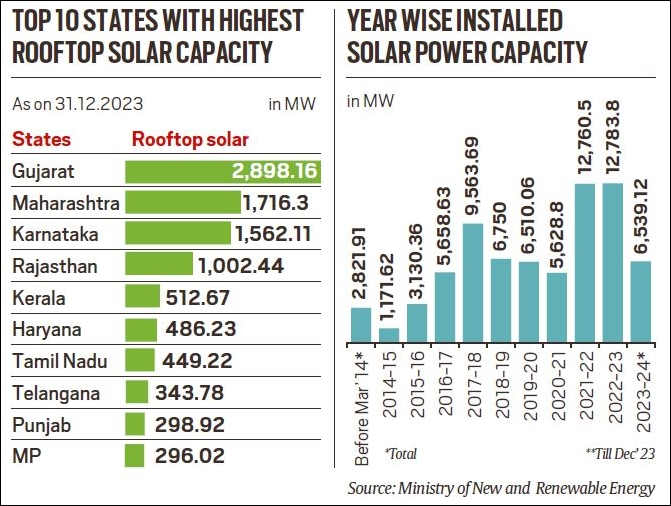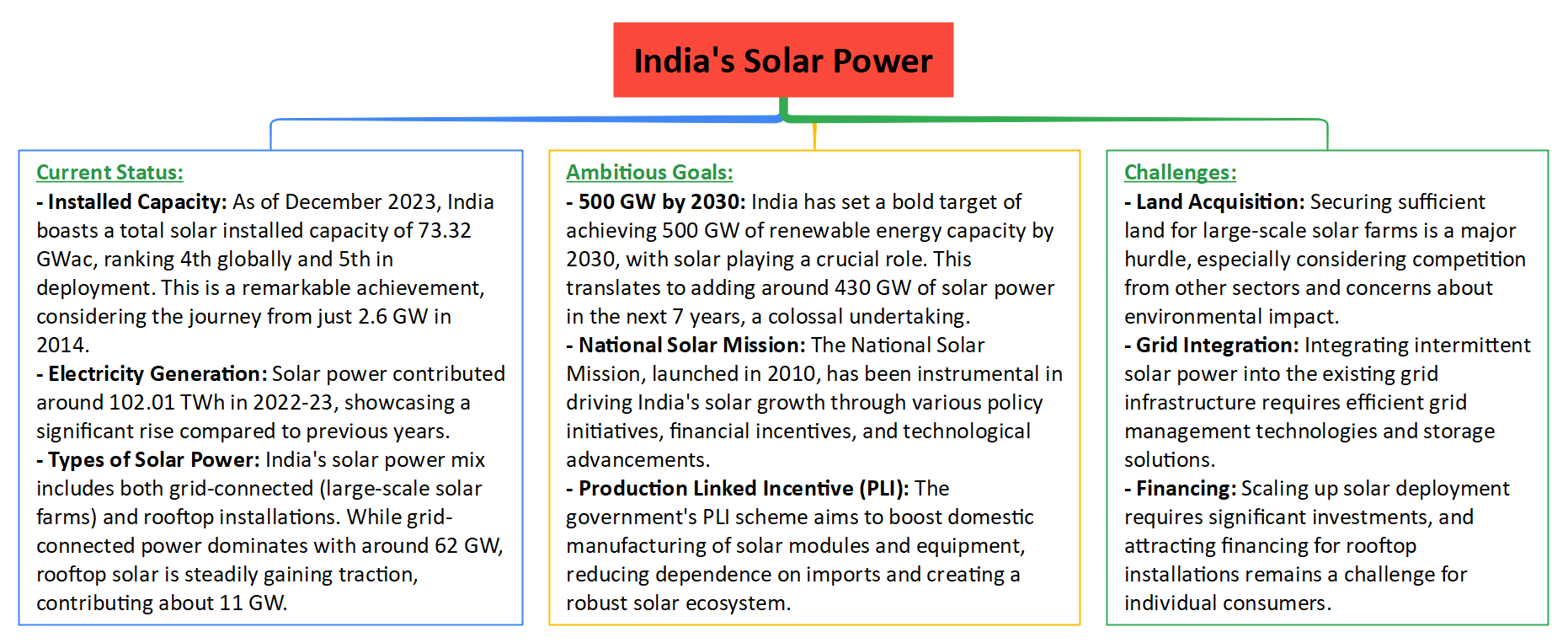Description
 Copyright infringement not intended
Copyright infringement not intended
Picture Courtesy: economictimes.indiatimes.com
Context: India aims to achieve 50% of its installed capacity of electricity generation from non-fossil fuel-based energy sources by 2030, with a significant emphasis on solar power, specifically through the implementation of grid-connected rooftop systems.
Details
- The solar power program, initiated in 2014 with a target of installing 100 GW of solar power by 2022, has fallen behind schedule. As of the end of 2023, the total solar installed capacity in the country reached only 73.3 GW, with grid-connected rooftop solar contributing about 11 GW.
Pradhan Mantri Suryodaya Yojana
- To rejuvenate the solar power initiative, the Prime Minister announced the Pradhan Mantri Suryodaya Yojana. The program aims to accelerate decentralized solar power in the country by targeting a specific number of households.
- While previous initiatives primarily targeted commercial and industrial sectors, the new program focuses on individual households. Currently, the residential sector accounts for only 20% of rooftop solar installations, presenting a vast untapped potential.
Potential in the Residential Sector
- A report by the Council on Energy, Environment, and Water (CEEW) suggests that the approximately 25 crore households in India have the potential to deploy 637 GW of solar energy on rooftops.
- Even achieving one-fifth of this potential, around 118 GW, could meet the entire electricity demand from the residential sector.

Uniform Potential Across States
- Unlike large solar parks that require substantial investments and specific geographical conditions, the potential for rooftop solar is uniformly distributed across all states and regions.
Challenges and Solutions
- The government must incentivize the installation of rooftop solar on individual households.
- Financial incentives are essential, but other measures, learned from ongoing programs, need to be implemented to create an enabling environment for greater penetration.
- Empowering distribution companies, without imposing additional financial burdens, are crucial for the success of the new program.
Energy Security and Transition
The overarching objectives of these programs are to ensure energy security, transition to non-fossil fuel sources, and increase energy access. India's commitment to achieving 50% of electricity generation from non-fossil fuel-based sources by 2030 underscores the urgency for rapid growth in renewable energy, particularly solar power.

India’s Solar Power
- India is a country with abundant solar energy potential. With about 300 clear and sunny days in a year, the country receives about 5,000 trillion kWh of solar energy annually, which is more than the total energy output of all the fossil fuels in India.
- Solar power can provide a clean, green and sustainable solution to India's growing energy needs and help address the challenges of climate change.
Solar power has several features that make it attractive for India
- It is a renewable and inexhaustible source of energy that can reduce India's dependence on fossil fuels and enhance its energy security.
- It is a decentralized and distributed form of energy that can cater to the needs of both rural and urban areas, especially in remote and inaccessible regions where grid connectivity is poor or absent.
- It is a cost-effective and competitive source of energy that can reduce the burden on consumers and utilities by lowering the cost of electricity generation and transmission.
- It is an environment-friendly and climate-resilient source of energy that can reduce greenhouse gas emissions and mitigate the impacts of global warming.
Solar power has significant benefits for India's socio-economic development
- It can create employment opportunities at various levels of the value chain, from manufacturing to installation to operation and maintenance.
- It can spur innovation and entrepreneurship in the solar sector by encouraging research and development, technology transfer and capacity building.
- It can improve the quality of life and standard of living of millions of people by providing them access to clean, reliable and affordable electricity for lighting, cooking, heating, cooling and other purposes.
- It can support various sectors of the economy such as agriculture, industry, transport, health, education and tourism by enhancing their productivity and efficiency.
.jpg)
Steps taken to promote solar power development
- The Ministry of New and Renewable Energy (MNRE) is the nodal ministry for implementing policies and programmes related to solar power in India. It provides various incentives and subsidies for solar projects such as capital subsidies, generation-based incentives, viability gap funding, accelerated depreciation, tax benefits, etc.
- The Solar Energy Corporation of India (SECI) is a public sector undertaking under MNRE that acts as an intermediary agency for implementing various schemes such as grid-connected solar parks, rooftop solar systems, canal-top solar projects, floating solar projects, etc. It also conducts auctions for awarding solar power projects to developers through competitive bidding.
- The National Institute of Solar Energy (NISE) is an autonomous institution under MNRE that acts as a centre of excellence for research and development in solar energy. It also provides training and consultancy services for solar projects. It has established a network of 121 solar radiation resource assessment stations across India to measure and map the solar potential of the country.
- The International Solar Alliance (ISA) is an intergovernmental organization initiated by India and France in 2015 at the Paris Climate Conference (COP21). It aims to mobilize resources and cooperation among 121 countries lying between the Tropic of Cancer and the Tropic of Capricorn for harnessing solar energy to meet their common energy needs. India hosts the headquarters of ISA in Gurugram, Haryana.
- The One Sun One World One Grid (OSOWOG) is a visionary concept proposed by India to create a global network of interconnected solar grids that can share solar power across regions and time zones. It envisages three phases: first, connecting the grids of India, the Middle East and Southeast Asia; second, connecting the grids of Africa and Europe; and third, connecting the grids of the Americas.
- The World Solar Bank (WSB) is a proposed financial institution that would provide low-cost and long-term financing for solar projects in ISA member countries. It would be set up with an initial capital of $10 billion, of which India would contribute $2 billion.
Challenges
|
Land availability
|
Acquiring land for large-scale solar projects is a complex and time-consuming process that involves multiple stakeholders such as landowners, local communities, government authorities, etc. It also entails high costs and environmental and social impacts.
|
|
Grid integration
|
Integrating variable and intermittent solar power into the existing grid requires adequate infrastructure and management such as transmission lines, substations, balancing mechanisms, forecasting systems, etc. It also poses technical and regulatory challenges such as grid stability, power quality, grid codes, scheduling, dispatching, etc.
|
|
Rooftop solar
|
Despite having a huge potential of 40 GW, rooftop solar has been lagging in India due to various barriers such as lack of awareness, high upfront cost, low financing options, complex procedures, regulatory hurdles, etc.
|
|
Storage
|
Storage is a key enabler for increasing the reliability and flexibility of solar power. However, storage technologies such as batteries are still expensive and have limited availability and scalability in India.
|
|
Innovation
|
Innovation is essential for improving the efficiency and affordability of solar power. However, India faces a gap in innovation capacity due to low investment in research and development, weak intellectual property rights protection, limited technology transfer and collaboration, etc.
|
Way forward
- Land optimization: Optimizing the land use for solar projects by exploring alternative options such as wasteland, barren land, agricultural land, canal-top, floating, building-integrated, etc. It also involves engaging with the stakeholders and ensuring their participation and consent in the land acquisition process.
- Grid enhancement: Enhancing the grid infrastructure and management by expanding and upgrading the transmission and distribution network, deploying smart grid technologies such as advanced metering, demand response, etc., adopting grid-friendly policies and regulations such as net metering, feed-in tariff, renewable purchase obligation, etc.
- Rooftop solar promotion: Promoting rooftop solar by creating awareness and outreach programmes among potential consumers, providing financial incentives and subsidies for installation and maintenance, facilitating easy access to credit and financing options from banks and other institutions, simplifying the procedures and norms for approval and connection, etc.
- Storage development: Developing storage solutions by supporting research and development in emerging technologies such as lithium-ion, flow batteries, hydrogen fuel cells, etc., creating a conducive ecosystem for manufacturing and deployment of storage devices, incentivizing the integration of storage with solar projects through tariffs and subsidies, etc.
- Innovation acceleration: Accelerating innovation by increasing public and private investment in research and development in solar energy, strengthening intellectual property rights protection and enforcement mechanisms, fostering technology transfer and collaboration among domestic and international players in the solar sector, encouraging entrepreneurship and start-ups in the solar domain, etc.
Conclusion
- India's solar power journey is an inspiring example of how a developing country can harness its natural resources to meet its energy needs while contributing to global efforts to combat climate change. With its visionary leadership, proactive policies and programmes, collaborative partnerships and innovative initiatives, India is poised to become a global leader in solar energy in the coming years.
Must Read Articles:
Rooftop Solar Programme: https://www.iasgyan.in/daily-current-affairs/rooftop-solar-programme#:~:text=When%20the%20sun%20shines%20onto,a%20residential%20or%20commercial%20building.
Pradhan Mantri Suryodaya Yojana: https://www.iasgyan.in/daily-current-affairs/pradhan-mantri-suryodaya-yojana
|
PRACTICE QUESTION
Q. The growing solar industry holds the promise of creating new jobs. How can India ensure its workforce has the necessary skills and training to capitalize on these opportunities and bridge the gap between the current skills available and the industry's requirements?
|
https://t.me/+hJqMV1O0se03Njk9





 Copyright infringement not intended
Copyright infringement not intended











